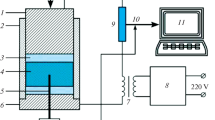Abstract
The subject investigated was the behavior of a nanocrystallite submicron ZrO2−Y2O3 ceramic which was obtained by the plasma-chemical synthesis method using explosive loading. It was shown that the dynamic action results in a qualitative change in the powder particle morphology, a stored deformation energy increase and a phase transition which promotes the activation of the sintering process.
Similar content being viewed by others
References
N. G. Scott, “Zirconia rich end of the ZrO2−Y2O3 diagram,” J. Mater. Sci.,10, 1527 (1975).
V. E. Panin, V. F. Nesterenko, S. N. Kul'kov et al., “Fragmentation of submicron ceramic powders during pulsed loading,” Fiz. Goren. Vzryva,27, No. 4, 140 (1991).
V. F. Nesterenko, V. E. Panin, S. N. Kulkov et al., “Modification of submicron ceramics under pulse loading,” High Press. Res.,10, No. 5-6, 791 (1992).
R. Pryummer, Explosion Treatment of Powdered Materials [Russian translation], Mir, Moscow (1990).
V. F. Nesterenko, Pulsed Loading of Heterogeneous Materials [in Russian], Nauka, Novosibirsk (1992).
F. F. Lange, “Size effects associated with the thermodynamics of constrained transformations,” J. Mater. Sci.,17, 225 (1982).
L. M. Lityagina, S. S. Kabalkina, T. A. Pashkina et al., “Polymorphism at high pressure,” Fiz. Tverd. Tela,20, No. 11, 3475 (1978).
Jue J. Fong and A. V. Virkar, “Fabrication, microstructural characterization and mechanical properties of polycrystalline t'zirconia,” J. Am. Ceram. Soc.,73, 3650 (1990).
D. T. Lively and P. Murray, “Thermodynamics of monoclinic-tetragonal transition of zirconia,”ibid.,39, 363 (1956).
E. D. Whitney, “Effect of pressure on monoclinic-tetragonal transition of zirconia. Thermodynamics,”ibid.,45, 612 (1962).
T. Masaki and K. Sinjo, “Mechanical properties of highly toughened ZrO2−Y2O3,” Ceram. Int.,13, 109 (1987).
M. E. Kipp and D. E. Grady, “Elastic wave dispersion in high-strength ceramics,” in: Shock Compression of Condensed Matter, Elsevier Sci. Publ. B. V. (1992), p. 459.
V. F. Nesterenko, T. S. Teslenko, V. A. Simonov et al., “Formation of new materials from ceramic powders with nanocrystallite structure using high-energy action,” IGIL Report, June 1993.
V. A. Dubok, M. I. Kabanova, S. A. Nedil'ko et al., “Effect of the synthesis method on the properties of partially stabilized zirconium dioxide powders,” Poroshk. Metall., No. 8, 56 (1988).
Additional information
M. A. Lavrent'ev Hydrodynamics Institute, Novosibirsk. Institute of Strength and Material Physics, Tomsk. Translated from Fizika Goreniya i Vzryva, Vol. 29, No. 6, pp. 66–72, November–December, 1993.
Rights and permissions
About this article
Cite this article
Kul'kov, S.N., Nesterenko, V.F., Bondar', M.P. et al. Explosion activation of quench-hardened ZrO2-Y2O3 ceramic submicron powders. Combust Explos Shock Waves 29, 728–733 (1993). https://doi.org/10.1007/BF00786857
Received:
Issue Date:
DOI: https://doi.org/10.1007/BF00786857




